The NVIDIA SHIELD Tablet Review
by Joshua Ho on July 29, 2014 9:00 AM ESTGPU Benchmarks
On the GPU side, the Tegra K1's GPU is derived from the same Kepler GPU architecture we've seen in notebooks and desktops - albeit in a single SMX configuration. There are some power focused changes to mobile Kepler, and I’d reference our initial article on Tegra K1’s architecture for those interested in learning more. In this device, the GPU can run anywhere between 72 MHz to 852 MHz.
I included Surface Pro in a couple of the tests below just to show how far NVIDIA's Shield Tablet and Tegra K1 get in terms of pushing the envelope in gaming performance. Tegra K1 can deliver better GPU performance than the original Surface Pro, and given its price and thermal constraints isn't too far off of the newer Surface Pro tablets as well.
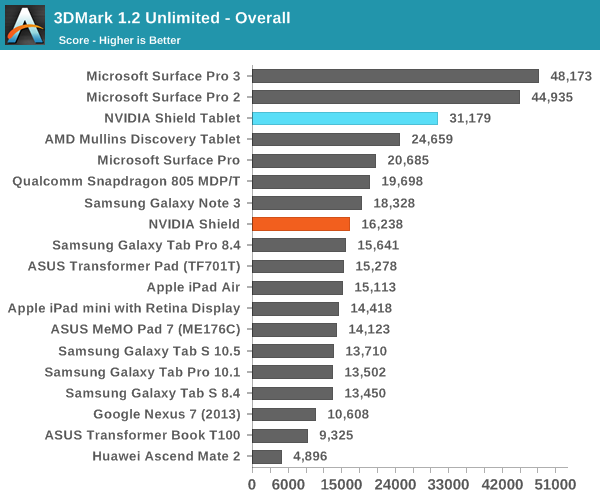
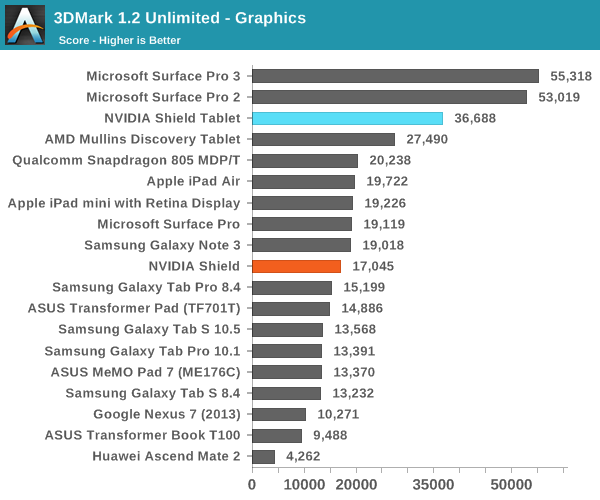

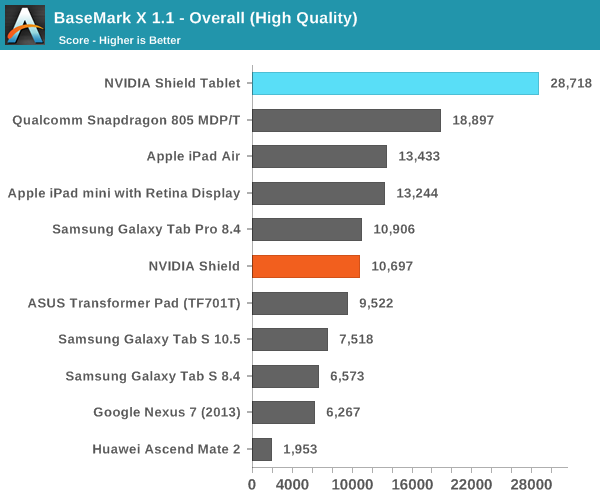
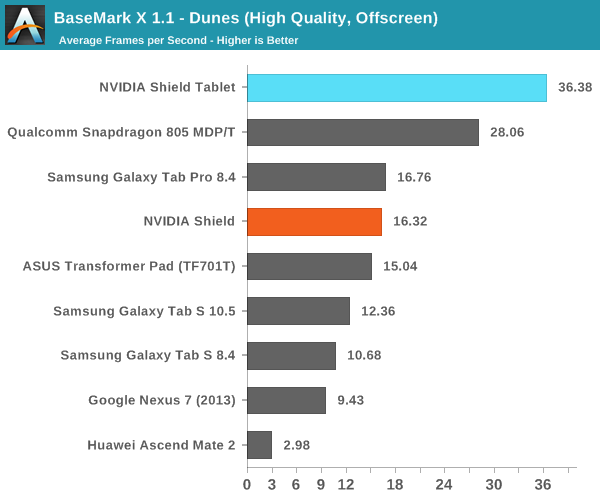
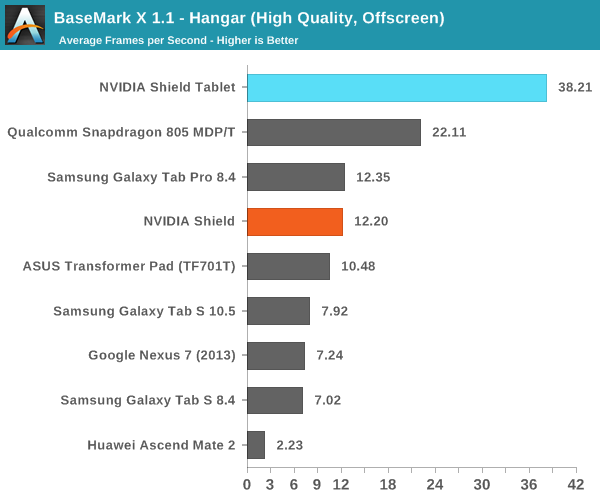
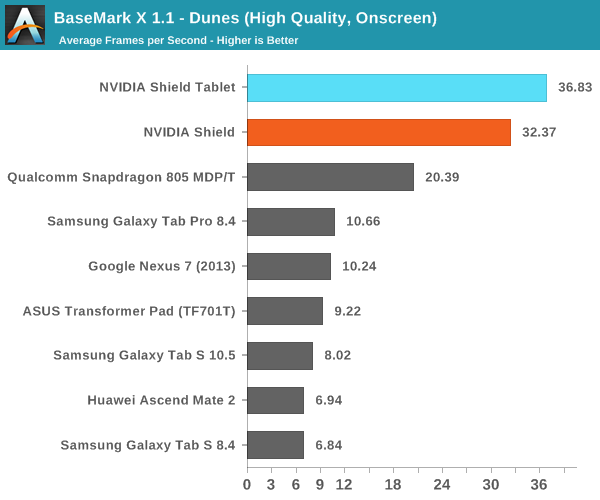
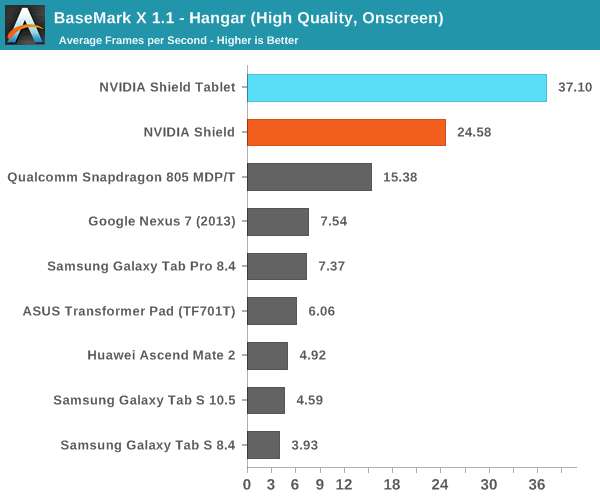
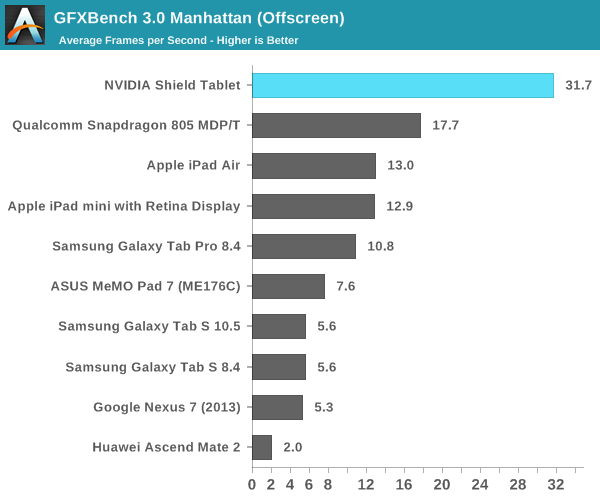
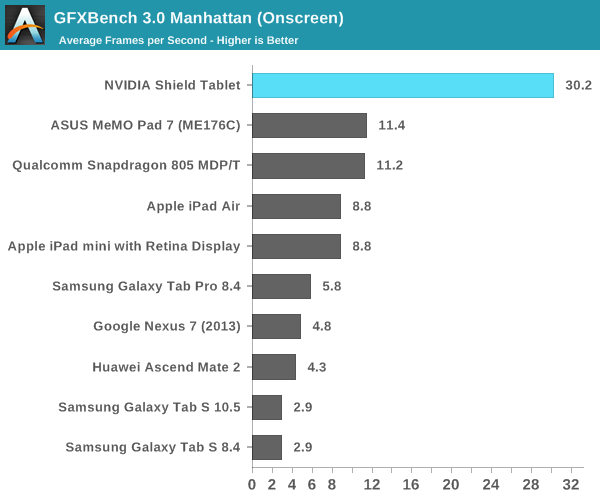
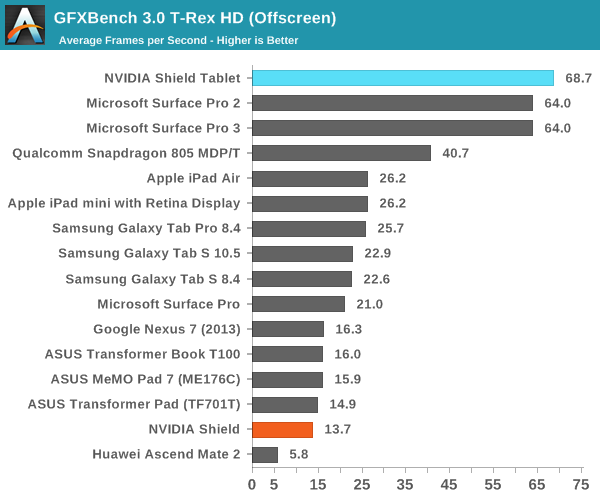
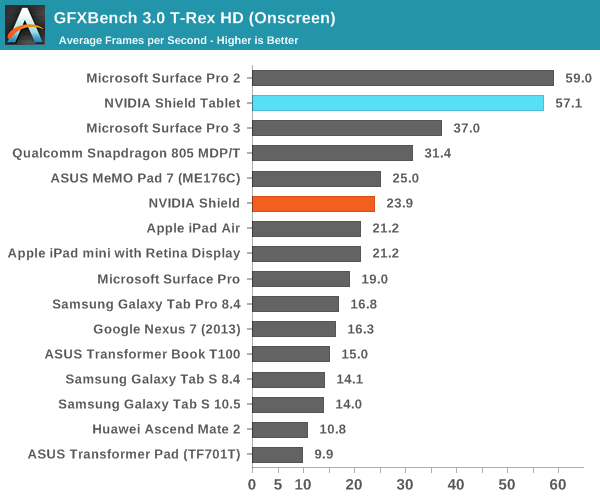
When it comes to GPU performance, there’s really no question: the Tegra K1 is easily the fastest in all of our GPU benchmarks. It handily beats every other ARM SoC, including the newest generation of SoCs such as the recently introduced Snapdragon 805 and its Adreno 420 GPU. It's worth noting that the Snapdragon 805 is likely aimed more at smartphones than tablets, although we are looking at its performance in Qualcomm's tablet development platform here. Until we get a look at Snapdragon 805 power consumption we can't really draw any perf/watt conclusions here. Ultimately, the only thing that can top the Shield Tablet is Surface Pro line, which uses more powerful laptop-class hardware.










174 Comments
View All Comments
Wolfpup - Tuesday, July 29, 2014 - link
Wish it had a larger screen. I'd really love a 12" screen for graphic novels and magazines, but I at least want 10".Regarding Half-Life...it's awesome it runs on this, but super lame it I guess REQUIRES Nvidia hardware to run? Android's already a big enough mess as it is. I don't need programs that only run on some and not all Android devices.
Wolfpup - Tuesday, July 29, 2014 - link
I wonder about the controller too...it seems very nice, but wondering if it'll work with PC games or iOS for that matter.vision33r - Tuesday, July 29, 2014 - link
Those of us that owned the 1st gen Shield love it because of the portability and form factor. I am able to use it on the train or plane easily like a NDS. This thing now requires that I put it on the dock or stand.I think they would be better off releasing a Shield with 5.7" display edge to edge instead of the big border.
I can play most games like Skyrim on a 5" display well just annoyed by the border.
chizow - Tuesday, July 29, 2014 - link
If you listen to the MaxPC webcast with Tom Petersen, I think there is a very good chance we see an updated Shield Portable 2. Not sure about a bigger screen, I'd get one too if it had a 6" 1080p screen and TK1, but there's a good chance it has its SoC updated. I am 99% sure Nvidia said TK1 is pin compatible with T4, so it would be an easy upgrade.TheJian - Wednesday, July 30, 2014 - link
Agreed, shield r2 is coming. They have said recently they serve different markets (and they do). There was no mention of it not being revved yearly and specs are out for 4GB, 1440x810 etc. That is no where near this device and seems likely a perfect update to Shield 1 and more geared towards handheld hardcore gamers. Shield was only 10mil to develop, so plopping in K1 shouldn't be much more if they stick with the same design etc, just amp a few things up (memory etc). No need for a massive redesign it was already good. Sticking with 720p or just above should save on power also, again more in line with a handheld usage playing games. MHL 3.0, usb 3.0 and support for a large SD card is all I'd need to jump I think.They said K1 32 and 64 Denver K1 is pin compatible, but not T4. But that's not a huge redesign considering the whole thing only cost 10mil the first time. They only needed to sell about 100K-150K to break even probably (assuming $100 or so profits for each sold based on ~160 vita cost, and 101 for 3ds BOM at launch for them). Everything from Vita/3ds got shrunk so costs are probably similar.
GC2:CS - Tuesday, July 29, 2014 - link
When nvidia had showed its prototype Kepler mobile GPU for the first time for examination here on anadtech I was excited as it showed it was drastically more efficient and faster than the king of mobile GPU's at that time the A6X. It just kind of blew it away, even though Apple really gone wild when talking about SoC's: a custom CPU architecture, a GiGantic GPU, huge amounts of bandwidth etc. But with such Kepler GPU they could afford to wait for a year and still beat everyone at least in theory.But in reality ? A year after Kepler prototype, we have well.... two tablets and an all in one ? And after a year even the power and performance story doesn't look as good as interpreted by nvidia.
After a year we got the new Apple A7 that nVidia claimed about that their new K1 is 3x faster and 50 % more efficient.
Lets compare them now.
A7 gets 13 fps in manhattan and K1 over 30 fps, but still well short of 3x which is.13by3...wait...... about 39 fps. So about 2,4 times faster in comparison, still nice.
Then there is efficiency. Running down a 19.75 battery in 2.2 hours with a display that consumes AT MOST 1,46 W at 200 nits yields an power consumption of all other components of AT LEAST 7,3W (most of that is the SoC+RAM) which is downright ridiculous. Then there is throttling. Maybe it doesn't look significant on that chart, but it reached vsync in first dozen runs. Taking into consideration off screen tests, without vsync it would run at about 63,5 at native resolution and it would start throttling sooner. Now going down to 46,1 thats a difference of 27%. Still nice for so many runs, but not all tablets have dedicated magnesium heat spreader installed in them and I don't think it will be problem for a gamer to play a PC game port for 70 minutes or more non-stop. But the bad thing is that it throttles even with that heat spreader, and that means its really hot.
And now lets compare with A7. Its got far far lower power compustion under full load and also generates far less heat, so it the GPU doesn't throttle at all. Taking this into consideration, the tegra can be less than 2,4 x the A7, especially in tablets without custom heat spreaders and after prolonged use. And ouch a phone ! You can put the A7 into a phone ! And the GPU doesn't throttle at all as well. And then the A7 is 10 months old chip and still tegra has a hard time even in terms of efficiency. The A8 will be entirely different league, it will crush tegra, not it performance, but in efficiency.
Considering all of this it just kind of dissapoints me.
identity - Tuesday, July 29, 2014 - link
iSheep trying to spread that Apple propaganda lol! Nice try though :)melgross - Tuesday, July 29, 2014 - link
The fact that you feel the need to use that word just shows that your thinking is very limited. If you have something useful to say, try to refute what he said instead. Stop acting as though you're 12 years old.ams23 - Tuesday, July 29, 2014 - link
Mobile Kepler in Tegra K1 is roughly 50% more power efficient than G6430 in A7 with GFXBench 3.0 Manhattan Offscreen test: http://images.anandtech.com/doci/7622/Screen%20Sho...Regarding throttling, there is virtually no throttling on Shield tablet until after 115 (!) runs: http://images.anandtech.com/doci/8296/TRexRunDownG... . You can see that Onscreen fps only varies by a couple fps during that time.
As for battery life, Shield tablet has a battery saver mode which should result in superior battery life for gaming.
At the end of the day, mobile Kepler can reach performance levels and playable settings that other thin fanless tablets currently on the market cannot even hope to reach. I would much rather have 3 hours of smooth and playable gameplay at 30-60fps than 5 hours of non-playable gameplay at 15-25fps.
melgross - Tuesday, July 29, 2014 - link
That's very true. But this is a new chip, and the A7 is now becoming an old chip, by the standards of mobile development. It will be interesting to see whether Apple can improve the A8 by the amounts they've been doing the past generations. Rumor has it that it will again be a 2 core design. If so, it could lead to some interesting strategies on the part of Apple.But, like anything else, we'll have to wait.